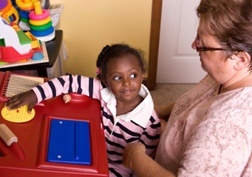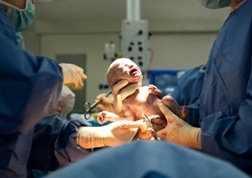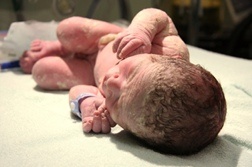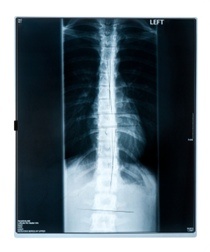LAWSUITS NEWS & LEGAL INFORMATION
Erb's Palsy Birth Injury
Erb's Palsy is a paralysis of the arm caused by injury to the upper group of the arm's main nerves (specifically, spinal roots C5-C7 ) in the brachial plexus. It is almost always a birth injury, which could result from an abnormal or difficult childbirth or labor. It can also be a result of medical malpractice, such as excessive pulling on the shoulders during delivery, or if the infant's head and neck are pulled toward the side at the same time as the shoulders pass through the birth canal.
 Erb's Palsy is the name for damage that is caused to the nerves. These nerves extend bilaterally from the neck and shoulder area to the upper extremities and are responsible for controlling the muscles in the arms, hands, and fingers. Erb's palsy is most often the result of shoulder dystocia. Shoulder dystocia is a birth complication that occurs when a baby's shoulders get stuck on a mother's pelvic bone. This can result in damage to the nerves of the brachial plexus including stretching, tears, rupture or avulsion of the affected nerves. This can cause limpness, reduced sensation, paralysis, or lack of muscle control in the upper limbs.
Erb's Palsy is the name for damage that is caused to the nerves. These nerves extend bilaterally from the neck and shoulder area to the upper extremities and are responsible for controlling the muscles in the arms, hands, and fingers. Erb's palsy is most often the result of shoulder dystocia. Shoulder dystocia is a birth complication that occurs when a baby's shoulders get stuck on a mother's pelvic bone. This can result in damage to the nerves of the brachial plexus including stretching, tears, rupture or avulsion of the affected nerves. This can cause limpness, reduced sensation, paralysis, or lack of muscle control in the upper limbs.
Medical malpractice may also take place when a doctor, justifiably anxious about the possibility of the baby suffocating, uses excessive or misdirected force to reposition the baby, tearing nerves and causing Erb's palsy or another brachial plexus palsy. If these medical errors lead to a birth injury such as Erb's palsy, you have the legal right to sue for compensation for your medical bills, your child's pain and your own trauma.
 While most cases of Erb's palsy are healed within six to 24 months, according to the American Academy of Family Physicians, about 10 percent of them are lifelong conditions. Those babies will grow up with limited or no use of that arm, sometimes without feeling and with a limp, atrophied arm that marks them as different from other children. They may need multiple surgeries and physical therapy.
While most cases of Erb's palsy are healed within six to 24 months, according to the American Academy of Family Physicians, about 10 percent of them are lifelong conditions. Those babies will grow up with limited or no use of that arm, sometimes without feeling and with a limp, atrophied arm that marks them as different from other children. They may need multiple surgeries and physical therapy.
Those babies with Erb's palsy who heal within their first years of life usually still need extensive physical therapy to keep their joints alive and flexible. Authorities agree that treatment within the first year of an affected child's life increases his or her chances of recovery. Furthermore, the baby's family may feel extremely anxious about the possibility of a permanent disability for their child.
Erb's Palsy is one of the most common (and serious) shoulder dystocia injuries. Erb's Palsy results when a shoulder dystocia condition is mishandled, resulting in damage to the nerves connecting the neck and arm. Shoulder dystocia can stretch the nerve tissue and cause damage resulting in permanent paralysis of the arm.
 A properly trained obstetrician will identify any shoulder dystocia risks and take steps to avoid injury during the delivery. Increased risks of shoulder dystocia are linked to high birth-weight babies, overweight or obese mothers, and a long second stage of labor. Shoulder dystocia can be prevented by scheduling a caesarean section (c-section) for high-risk mothers. If shoulder dystocia occurs during the birthing process, there are 16 different techniques to free the trapped shoulder and ensure safe delivery. Shoulder dystocia is a serious situation, but does not have to result in injury.
A properly trained obstetrician will identify any shoulder dystocia risks and take steps to avoid injury during the delivery. Increased risks of shoulder dystocia are linked to high birth-weight babies, overweight or obese mothers, and a long second stage of labor. Shoulder dystocia can be prevented by scheduling a caesarean section (c-section) for high-risk mothers. If shoulder dystocia occurs during the birthing process, there are 16 different techniques to free the trapped shoulder and ensure safe delivery. Shoulder dystocia is a serious situation, but does not have to result in injury.
About 1 or 2 babies in 1,000 suffer brachial plexus injuries at birth, and about 1 in 10 of these babies need treatment. Unfortunately, medical mistakes do occur and in the case of shoulder dystocia, the mistakes can be lasting with conditions such as Erb's Palsy.
 Brachial Plexus Palsy occurs when the brachial plexus, a network of nerves, is damaged. Since the brachial plexus conducts signals from the spine to the arm and hand when it is damaged a limp arm can result. The brachial plexus is a network of nerves formed by fibers, which are located between the shoulder and the neck. Most often brachial plexus injuries happen during birth when excessive lateral traction is applied to the fetal neck region. In cases of brachial plexus palsy the upper part of the brachial plexus is involved. The brachial plexus palsy injuries are 90% of the time caused by traumatic stretching of the plexus during birth. Many babies with brachial plexus injuries are larger than average at birth.
Brachial Plexus Palsy occurs when the brachial plexus, a network of nerves, is damaged. Since the brachial plexus conducts signals from the spine to the arm and hand when it is damaged a limp arm can result. The brachial plexus is a network of nerves formed by fibers, which are located between the shoulder and the neck. Most often brachial plexus injuries happen during birth when excessive lateral traction is applied to the fetal neck region. In cases of brachial plexus palsy the upper part of the brachial plexus is involved. The brachial plexus palsy injuries are 90% of the time caused by traumatic stretching of the plexus during birth. Many babies with brachial plexus injuries are larger than average at birth.

Examples of different symptoms of Erb's Palsy:
Last updated on
FREE ERB'S PALSY BIRTH INJURY LAWSUIT EVALUATION
Send your Erb's Palsy Birth Injury claim to a lawyer who will review your claim at NO COST or obligation.
GET LEGAL HELP NOW
GET LEGAL HELP NOW
 Erb's Palsy is the name for damage that is caused to the nerves. These nerves extend bilaterally from the neck and shoulder area to the upper extremities and are responsible for controlling the muscles in the arms, hands, and fingers. Erb's palsy is most often the result of shoulder dystocia. Shoulder dystocia is a birth complication that occurs when a baby's shoulders get stuck on a mother's pelvic bone. This can result in damage to the nerves of the brachial plexus including stretching, tears, rupture or avulsion of the affected nerves. This can cause limpness, reduced sensation, paralysis, or lack of muscle control in the upper limbs.
Erb's Palsy is the name for damage that is caused to the nerves. These nerves extend bilaterally from the neck and shoulder area to the upper extremities and are responsible for controlling the muscles in the arms, hands, and fingers. Erb's palsy is most often the result of shoulder dystocia. Shoulder dystocia is a birth complication that occurs when a baby's shoulders get stuck on a mother's pelvic bone. This can result in damage to the nerves of the brachial plexus including stretching, tears, rupture or avulsion of the affected nerves. This can cause limpness, reduced sensation, paralysis, or lack of muscle control in the upper limbs.Medical malpractice may also take place when a doctor, justifiably anxious about the possibility of the baby suffocating, uses excessive or misdirected force to reposition the baby, tearing nerves and causing Erb's palsy or another brachial plexus palsy. If these medical errors lead to a birth injury such as Erb's palsy, you have the legal right to sue for compensation for your medical bills, your child's pain and your own trauma.
 While most cases of Erb's palsy are healed within six to 24 months, according to the American Academy of Family Physicians, about 10 percent of them are lifelong conditions. Those babies will grow up with limited or no use of that arm, sometimes without feeling and with a limp, atrophied arm that marks them as different from other children. They may need multiple surgeries and physical therapy.
While most cases of Erb's palsy are healed within six to 24 months, according to the American Academy of Family Physicians, about 10 percent of them are lifelong conditions. Those babies will grow up with limited or no use of that arm, sometimes without feeling and with a limp, atrophied arm that marks them as different from other children. They may need multiple surgeries and physical therapy.Those babies with Erb's palsy who heal within their first years of life usually still need extensive physical therapy to keep their joints alive and flexible. Authorities agree that treatment within the first year of an affected child's life increases his or her chances of recovery. Furthermore, the baby's family may feel extremely anxious about the possibility of a permanent disability for their child.
Shoulder Dystocia
[Shoulder Dystocia] is an obstetric emergency with the potential to severely injure both mother and child. A shoulder dystocia happens when the baby's shoulder becomes stuck behind the mother's pubic bone during delivery; most shoulder dystocia situations are diagnosed when the baby's head delivers but the shoulders do not follow. If shoulder dystocia occurs, any amount of traction placed on the baby's head can cause severe nerve injury. Shoulder dystocia is one of the most difficult complications that can occur during delivery, because a shoulder dystocia situation carries such high risk for complications.Erb's Palsy is one of the most common (and serious) shoulder dystocia injuries. Erb's Palsy results when a shoulder dystocia condition is mishandled, resulting in damage to the nerves connecting the neck and arm. Shoulder dystocia can stretch the nerve tissue and cause damage resulting in permanent paralysis of the arm.
Risks During Delivery
 A properly trained obstetrician will identify any shoulder dystocia risks and take steps to avoid injury during the delivery. Increased risks of shoulder dystocia are linked to high birth-weight babies, overweight or obese mothers, and a long second stage of labor. Shoulder dystocia can be prevented by scheduling a caesarean section (c-section) for high-risk mothers. If shoulder dystocia occurs during the birthing process, there are 16 different techniques to free the trapped shoulder and ensure safe delivery. Shoulder dystocia is a serious situation, but does not have to result in injury.
A properly trained obstetrician will identify any shoulder dystocia risks and take steps to avoid injury during the delivery. Increased risks of shoulder dystocia are linked to high birth-weight babies, overweight or obese mothers, and a long second stage of labor. Shoulder dystocia can be prevented by scheduling a caesarean section (c-section) for high-risk mothers. If shoulder dystocia occurs during the birthing process, there are 16 different techniques to free the trapped shoulder and ensure safe delivery. Shoulder dystocia is a serious situation, but does not have to result in injury.About 1 or 2 babies in 1,000 suffer brachial plexus injuries at birth, and about 1 in 10 of these babies need treatment. Unfortunately, medical mistakes do occur and in the case of shoulder dystocia, the mistakes can be lasting with conditions such as Erb's Palsy.
Brachial Plexus Palsy
 Brachial Plexus Palsy occurs when the brachial plexus, a network of nerves, is damaged. Since the brachial plexus conducts signals from the spine to the arm and hand when it is damaged a limp arm can result. The brachial plexus is a network of nerves formed by fibers, which are located between the shoulder and the neck. Most often brachial plexus injuries happen during birth when excessive lateral traction is applied to the fetal neck region. In cases of brachial plexus palsy the upper part of the brachial plexus is involved. The brachial plexus palsy injuries are 90% of the time caused by traumatic stretching of the plexus during birth. Many babies with brachial plexus injuries are larger than average at birth.
Brachial Plexus Palsy occurs when the brachial plexus, a network of nerves, is damaged. Since the brachial plexus conducts signals from the spine to the arm and hand when it is damaged a limp arm can result. The brachial plexus is a network of nerves formed by fibers, which are located between the shoulder and the neck. Most often brachial plexus injuries happen during birth when excessive lateral traction is applied to the fetal neck region. In cases of brachial plexus palsy the upper part of the brachial plexus is involved. The brachial plexus palsy injuries are 90% of the time caused by traumatic stretching of the plexus during birth. Many babies with brachial plexus injuries are larger than average at birth.Types of Erb's Palsy
There are different types of brachial plexus injuries. Children with Erb's Palsy are all affected in different ways; depending on the type of nerve damage in Erb's Palsy children the symptoms can range from mild to severe. With Erb's palsy there are four different types of nerve injuries, including:
- an avulsion, meaning the nerve is torn from the spine
- a rupture, meaning the nerve is torn but not where it attaches to the spine
- a neuroma, meaning the nerve has tried to heal but scar tissue has grown around the injury placing pressure on the injured nerve praxis. While the nerve has been damaged, it has not been torn and improvement should be seen within 3 months.
- Neuropraxia is the mildest form of a nerve injury. Neuropraxia, the most common form of Erb's palsy is localized to the specific place where the injury occurs. It is a physiologic block of nerve conduction within an axon without any anatomical interruption. Many infants born with brachial plexus palsy have neuropraxia and sometimes recover within 4-6 weeks.
Symptoms of Erb's Palsy
Symptoms of Erb's Palsy are usually very obvious. A baby suffering from Erb's Palsy can be seen with the affected arm laying by their side and an extended elbow devoid of movement. The injuries that are associated to Erb's palsy are the neck, clavicle, shoulder, and arm. Some precautions should be used with children with brachial plexus injuries are shoulder or elbow dislocation, a frozen shoulder, soft tissue or joint contractures. Lifting a child with Erb's Palsy from under the armpits should always be avoided.Examples of different symptoms of Erb's Palsy:
- no muscle control and no feeling in the arm or hand
- little control of arm movements
- the use of hands but not of the shoulder or elbow
- the entire arm may be paralyzed with the hand and fingers hanging limp
- facial paralysis on the affected side
- not able to sit up without assistance
- the inability to crawl without the use of therapeutic devices.
Treatment for Erb's Palsy
Treatment for Erb's Palsy generally consists of daily exercise and physical therapy to improve functionality of joints and muscles. In about 20 percent of the cases, babies born with Erb's Palsy will greatly benefit from surgery between the ages of 5 and 12 months. Infants with brachial plexus palsy can benefit from surgical procedures to increase their arm functions. Since most children with Erb's Palsy have damage to multiple nerves of the brachial plexus, more than one procedure, preformed by a pediatric neurosurgeon, may be necessary.Erb's Palsy Birth Injury Legal Help
If your child has suffered from Erb's Palsy as a result of a birth injury, you may qualify for damages or remedies that may be awarded in a possible Erb's Palsy lawsuit. Please click on the link below to submit your Erb's Palsy complaint to a lawyer for a free case evaluation.Last updated on
ERB'S PALSY BIRTH INJURY LEGAL ARTICLES AND INTERVIEWS
Some Medical Professionals Ill-Informed About Erb's Palsy

Erb's Palsy: reports of negligence at birth

June 7, 2010
Erb's Palsy affects three out of every 2,000 live births in the US. According to medical writer Carrie Schmitt Harrison, the condition, which is typified by paralysis of the arm and stems from nerve damage, is more common than Down syndrome and muscular dystrophy. Yet there is a great deal of incorrect information out there. READ MORE
Erb's Palsy: reports of negligence at birth
April 24, 2006
Kristian was born December 28th, 2004 and we still don't know exactly what happened, but I'm sure Erb's Palsy could have been avoided. Now that I know my son is not going to be OK without surgery I am really mad. READ MORE
READ MORE Drugs/Medical Settlements and Legal News
READ MORE Malpractice Settlements and Legal News
READ MORE Personal Injury Settlements and Legal News
READ MORE Malpractice Settlements and Legal News
READ MORE Personal Injury Settlements and Legal News

READER COMMENTS
Erin Kasper
on
California
on
California
on
Result in severe speech delay and my son(6yr.) will come home crying because his friends can't understand him. I had a 3D ultrasound with proof of his size and I was not taken seriously.
Michigan
on